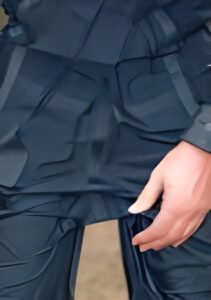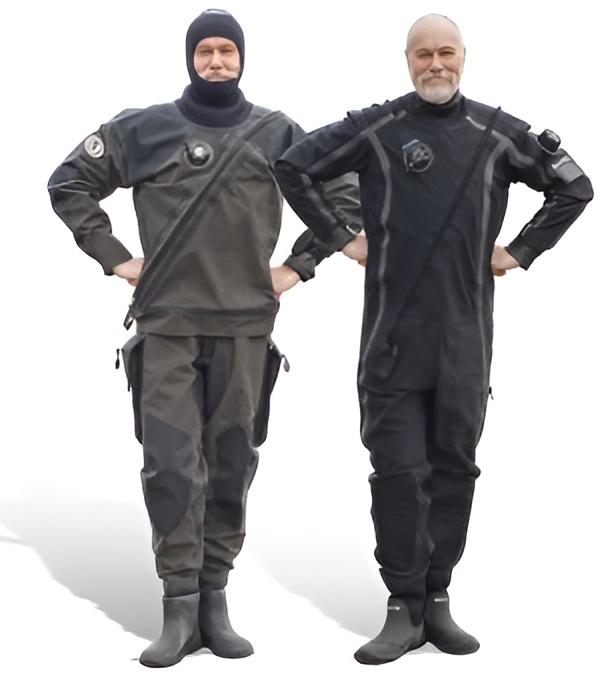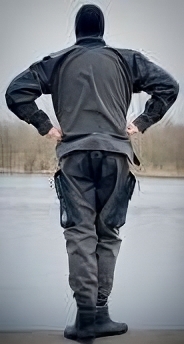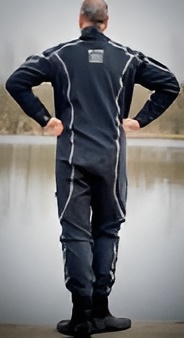Don’t sweat it – drysuits rarely come more expensive than this pair, but if you like the idea of underwater breathability, the buck pretty much stops here.
THERE IS SOMETHING UNDENIABLY PLEASANT about donning a 3mm wetsuit with a single tank and slipping into some warm tropical water but alas, for a British diver, that luxury is reserved for occasional trips somewhere overseas.
The reality more often than not is a dip into a very cold freshwater lake in winter, and this is when we certainly need a drysuit and all the insulating undergarments we can muster.
Last February I found myself yet again at Wraysbury Lake. The water, at only 5°C, was crystal-clear, and I enjoyed a couple of trips around the lake looking at old buses, traffic lights, numerous shipping containers and even some fairground seahorses.
Spying a discarded metalworker’s bench-vice, I reflected that I would have been thrilled to see such a thing in Truk Lagoon.
I was able to cover lots of ground because I was being propelled by my tank-mounted Pegasus Thruster, and I didn’t get cold because, besides the normal insulation one wears, I had the added luxury of a Thermalution heated vest.
Even at its lowest setting, this was enough to render both my face and hands toasty.
The problem with the Thruster is that it subjects the suit to a strong current, and that can reveal any weaknesses in its ability to keep the water out.
No problem, however – both the suits I used kept me totally dry and, even though at times the heated vest made me feel a little too hot, on neither occasion when I climbed out of the drysuit was there any clamminess from the dampness I had produced through sweat.
Why? Because both these suits are made from breathable material. The other thing they have in common is their prices, which are top-end and within a few pounds of each other.
We are all familiar with the properties of Gortex, the stuff that works so well in the rain but breathes to let the perspiration out. Well, these suits work in a similar way.
They vent the microclimate that would otherwise be formed by the natural precipitations from the skin.
All the jokes about the air I needed to inject into the suit to keep the volume constant leaking out, and me re-appearing like an effervescent tablet, seemed ill-founded.
Whenever anyone asks me which is the best drysuit for them, I tell them the one that fits them properly. With a drysuit, the fit is everything.
Dennis from Bare measured me up several times before the Bare SB suit arrived, so naturally it fitted me like a glove.
The Ursuit Kevlar BDS suit was off-the-peg, and although it seems I have now nearly achieved an off-the-peg shape, it was a little loose for me on the lower legs. I need to work on building up those calf muscles.
Bare SB
Bare is a Canadian company, owned by the same conglomerate that owns Atomic Aquatics, and it makes its suits in Malta. When it wanted a rethink of drysuit design, it went to BMW Designworks in California.
That company did its research and discovered that “drysuit diving is often cold, and the suit is too hot on land. The equipment is heavy, uncomfortable and complicated, and you don’t look very cool while doing it.” We could have told it that!
It came up with the idea of combining stretch with breathability.
I’m told that the Bare SB uses a blend of nylon, high-tenacity nylon and spandex for its outer shell, with a waterproof stretch breathable polyurethane membrane and nylon interior lining.
This is a front-entry suit with a diagonal watertight zip. A cleverly designed top layer hides the zip without need for any further cover.
The zip is also unconventional in that it’s a TiZip, which uses nylon combined with an aluminium runner.
I wondered whether the aluminium loop for the zip-pull would ever fail with the frantic tugging it’s bound to suffer over a period of time.
The SB uses a breathable fabric that has a certain amount of two-way stretch. This means that it can be made with a closer-to-your-skin fit than would otherwise be possible.
For its breathability to work, one must use an undergarment that works in the same way.
I used the Bare SB System Midlayer (previously reviewed in these pages) over a Merino wool vest and long john and the heated vest.
I climbed into the suit and noted that although there were fixings, no braces were supplied. After getting my arms in and my hands through the long latex wrist-seals, the suit has to be pulled up over the head to get through the neoprene neck-seal.
This neck-seal is best turned in on itself like an inverted polo-neck. This gives a good watertight seal that is very comfortable once cut to the right size.
Most suits of this type have an over-long torso to allow for this, but the Bare SB relies on its stretchiness to achieve the same result. Once the TiZip is fully closed, its pull-tag is concealed under a Velcro-covered flap.
There is also a concealed zipped pocket on the left thigh, but it doesn’t allow for much storage as it is against your leg. Bare is confident enough to give its suit a lifetime guarantee.
Ursuit Kevlar BDS
Made in Finland by Ursuk, this trilaminate suit is unashamedly aimed at those technical divers who follow a guru from Florida and always decompress while horizontal in the water. BDS stands for Breathable DrySuit.
It weighs little for a drysuit (around 3.6kg in size L) and so will suit the travelling diver, but its main selling proposition is its breathable nature, and it has Kevlar reinforcing at all the parts that might suffer additional wear. I’m told that this represents 20% of the suit’s outer area.
They call it the Heavy/Light, presumably because it can take heavy use but weighs little.
This is a similar front-entry diagonal-zip suit to the Bare SB, but it is more conventional in that it has an overlong torso to accommodate it being pulled up over the head.
This is taken care of afterwards by a tuck at the waist held in place by a crotch-strap. In this case the essential braces were supplied.
The BDS uses a conventional heavy-duty brass BDM dry zip that is neatly covered over by a layer of material and a second zip.
There are long conical latex wrist-seals and a latex neck-seal too. I found the neck-seal to
be exactly my size.
I wore the same combination of undergarments as I had with the Bare SB, and could pull both the zips closed without help.
There are two slim concertina pockets at the hips, closed by zips. These did not appear to
act as sea-anchors while swimming, although I seemed to be going more slowly with the Thruster, but perhaps the cold was starting to affect its battery performance.
Common Features
Besides the “breathability” element, a SiTech rotating inflation valve and constant-volume dump valves are included in the package.
Both suits came with comfortable, fitted and lined rubber boots, although I believe sock-ends and Rock-boots are an option with the BDS.
And both come with very nice carrying bags. A hood for the Bare SB suit is extra, but there is the option of a dry hood.
In The Water
Because the Bare SB suit had no braces, I found that the torso worked its way down to give me a dropped crotch and Nora Batty legs. This was reflected in the fact that I was unable to do a widely spaced frog-kick after a while.
Braces would have cured the problem. Otherwise it was as nice as swimming in a wetsuit without getting wet.
On the other hand, the Ursuit Kevlar kept all the suit up on my torso, thanks to its braces. I did experience air collecting in the lower legs, thanks in part to wearing a minimal amount of lead, and I felt I would have been more comfortable with some ankle-weights to counteract this.
As I’ve already said, with a drysuit a perfect fit is everything.

Because I wore the Ursuit Kevlar BDS for the second dive, and I had really warmed up by then, its breathability was probably far more apparent to the divers accompanying me.
They told me that there was a fine layer of bubbles, almost a haze, all over the suit while I was under water.
I certainly didn’t get wet, and my undersuit in both cases was as dry as a bone when I finished each dive, so the haze must have been my perspiration evacuating.
Conclusion
Both suits were excellent. I thoroughly enjoyed diving in both, but preferred the Bare SB only because it was made to fit me precisely, thanks to Dennis’s perseverance. Next time I use it, I will be employing internal braces with it.
The Ursuit Kevlar BDS is very tough. Both suits gave me an easy swim when I wasn’t using the Thruster to propel myself, and both kept me dry and comfortable. Both are top quality drysuits at top-of-the-range prices.
SPECS
URSUIT KEVLAR BDS
PRICE: £1600
SIZES: S to XXL
CONTACT: Liquid Sports website
MORE INFO: Visit URSUK website
DIVER GUIDE:
BARE SB
PRICE £1557
SIZES: 16 different off-the-peg
CONTACT: Visit BareSports website
MORE INFO: Visit Bare sbsystem website
DIVER GUIDE










